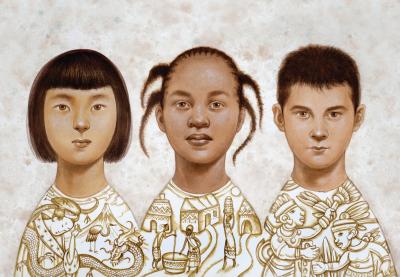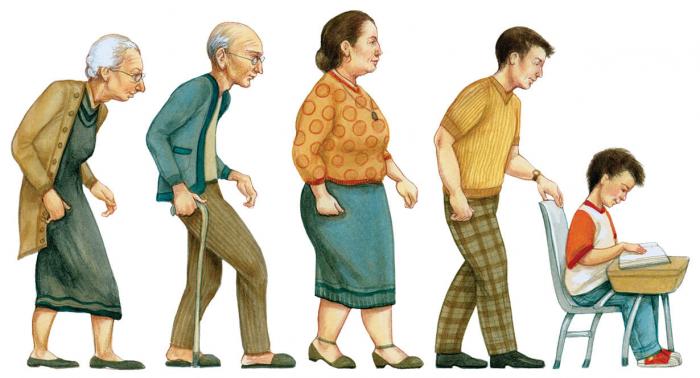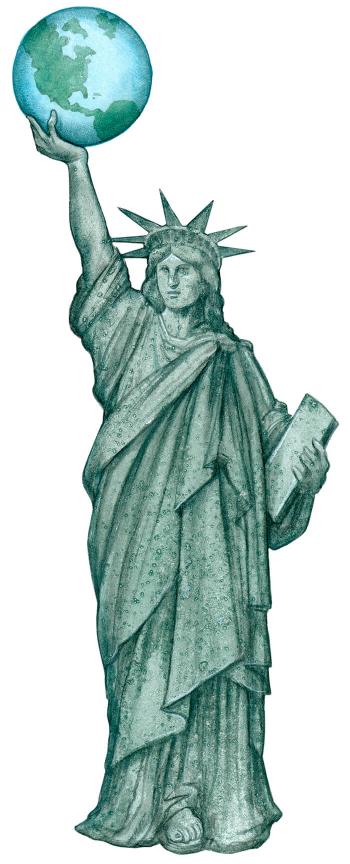

The students, in the leafy and historic town of Ridgefield, Conn., jump in eagerly to talk about what they know and what they’ve heard. It’s not long before their consensus is clear: Legal immigrants are good, model residents; “illegals” are very bad.
You can’t blame them for reaching that conclusion. After all, immigration has returned to the front burner of American politics. Last year, Arizona passed a series of laws hostile to immigrants. Thousands of Facebook users became fans of pages asserting, “This is America, I don’t want to press one for English,” and the term “anchor baby” entered our vocabulary (see No. 9 in “10 Myths About Immigration”).
In the past, nativists opposed immigration, period. The sharp distinction between “legal” and “illegal” immigrants emerged fairly recently, according to immigration historian David Reimers, a professor of history at New York University. “Basically, by the mid-90s ‘legal’ immigration was no longer an issue,” he says. “The hot-button issue became the undocumented immigrants.”
That makes immigration a powder keg for teachers. It’s a deeply important part of American history, a part of nearly everyone’s family legacy and present in almost every community. Many educators agree that concentrating on the power of personal stories helps students see how today’s immigrants are not that different from those in the past.
Most people living in the United States are here because someone in the last 400 years came here from somewhere else. Immigrant experiences are naturally strong for first- and second-generation immigrant families. But Reimer says that memories and language skills typically tend to fade by the third generation. It’s hard to understand the immigrant experience if your family has forgotten it. And forgetting, as Reimer suggests, has long been a part of assimilation.
Mindi Rappaport’s classroom—which we’ll return to later—is filled with students whose families have lost track of their roots. But across the country, in another eighth-grade English classroom, sit students whose immigration experience is firsthand.
Welcome to Dale Rosine’s class at Grace Yokley Middle School in Ontario, Calif. From time to time, Rosine sees new immigrants arrive in her class. When they first get there, she says, they are uncomfortable and afraid.
Sixty percent of Ontario’s population is Latino, with many people tracing their U.S. roots back to the 19th century. Like the rest of Southern California, Ontario is a divided camp when it comes to immigration. While unauthorized immigration is a hot political issue, the immigrants are a part of the fabric of life, with a cultural heritage shared by most residents. “Many people understand the reasons people come, [while] others are frustrated with the process,” Rosine says, adding that right now, “It has lots to do with economics.”
Rosine worries about her students. “Some of the students from Mexico talk about the way they feel disrespected and second-rate in society,” she says. “They see what their parents go through, what lies ahead, and what’s going to be available to them.”
“Some of them are really in pain,” she says.

Rosine was determined to use the students’ own experiences as a guide.
Her “Family Heritage” project aims to connect students—all of them—to their family backgrounds while promoting diversity and understanding in the classroom. “I look at students who see themselves as not smart, not worthwhile,” she says. “I try to build on what they can do and raise the expectations they have for themselves.”
She begins with the play The Diary of Anne Frank. She and her students discuss prejudice, oppression and Anne’s statement that “In spite of everything, I still believe that people are really good at heart.”
Halfway through the play, Rosine outlines the project. It calls for students to conduct family research, but not the “family tree” assignment, which experts warn can be painful for children who are adopted or fostered or whose families are separated. For children in those situations, Rosine suggests that they “choose the family who you see as family.”
Under Rosine’s guidance, students ask family members about their cultural heritage and the challenges they had to overcome. The students ask questions like, “Who came here [to the United States or to California] first?” and “What difficulties did they face?” Her students build a cultural identity for themselves as well as a family history of resilience.
Sometimes, Rosine admits, there’s reluctance from children whose families say, “Oh, we don’t know anything” about their origins. But a story usually emerges.
Rosine is after a real story, not just a cultural bazaar. She encourages her students to find out about the oppression and prejudice buried in the family history, and to ask elders to talk about the family’s hardships and worries. Some of her immigrant students talk about what it’s like to come over the border, she says, and they give voice to “the feeling of desperation and the fear of being deported.” Others, from all over the world, relate how their families were separated for years while one member in the United States worked to arrange for the others to come.
She’s had Japanese-American students who have told the story of their families being sent to internment camps and African-American students who learned about their ancestors leaving the South.
For some of her students, the experience really lowers walls. “When they hear so many kids with different backgrounds, and the difficulties they’ve had, it opens their eyes and makes their own situation seem less personal. They often remark that they thought they were the only ones who had experienced something until they heard their classmates’ stories.”
The project isn’t just about oppression, though. When they present their work, students bring in heirlooms or other items that are special to their families. “We’ve had wonderful artifacts,” Rosine says, “including Hawaiian sculpture, Filipino lanterns and ethnic clothing. We’ve also had military discharge papers and dog tags, as well as keepsakes that have been handed down for generations.”
As part of their presentations, students have shown pictures of dances and celebrations in which they’ve participated while visiting their family’s country of origin. They have also shared stories they’ve learned. Often, parents and grandparents come to class for the presentations, which are taped and photographed.
For Rosine, the payoff on the project comes when her students hear the presentations and are amazed to discover that the world is much bigger than they originally believed.
The New Colossus
Not like the brazen giant of Greek fame
With conquering limbs astride from land to land;
Here at our sea-washed, sunset gates shall stand
A mighty woman with a torch, whose flame
Is the imprisoned lightning, and her name
Mother of Exiles. From her beacon-hand
Glows world-wide welcome; her mild eyes command
The air-bridged harbor that twin cities frame.
“Keep, ancient lands, your storied pomp!” cries she
With silent lips. “Give me your tired, your poor,
Your huddled masses yearning to breathe free,
The wretched refuse of your teeming shore.
Send these, the homeless, tempest-tost to me,
I lift my lamp beside the golden door!”
— Emma Lazarus, 1883
Unguarded Gates
…. Wide open and unguarded stand our gates,
And through them presses a wild motley throng
Men from the Volga and the Tartar steppes,
Featureless figures of the Hoang-Ho,
Malayan, Scythian, Teuton, Kelt, and Slav,
Flying the Old World’s poverty and scorn;
These bringing with them unknown gods and rites,
Those, tiger passions, here to stretch their claws.
In street and alley what strange tongues are loud,
Accents of menace alien to our air,
Voices that once the Tower of Babel knew!
O Liberty, white Goddess! is it well
To leave the gates unguarded? On thy breast
Fold Sorrow’s children, soothe the hurts of fate,
Lift the down-trodden, but with hand of steel
Stay those who to thy sacred portals come
To waste the gifts of freedom. Have a care
Lest from thy brow the clustered stars be torn
And trampled in the dust. For so of old
The thronging Goth and Vandal trampled Rome,
And where the temples of the Caesars stood
The lean wolf unmolested made her lair.
— Thomas Bailey Aldrich, 1895
Mindi Rappoport’s eighth graders at Ridgefield’s East Ridge Middle School don’t seem to have much in common with Dale Rosine’s students—except for a teacher who wants them to appreciate diversity.
Ridgefield sits just inland from Connecticut’s wealthy “gold coast.” Rappoport describes it as an affluent community “with a blue-collar feel.” The students in her English class are mainly white, with “a smattering of ethnic minorities and immigrants.”
“It’s a pretty white-washed world,” Rappoport says of the small city of Ridgefield. “I try to confront students’ limited perspectives.” The big challenge, she adds, “is that they don’t realize they have a limited perspective.”
In Connecticut, essential questions drive the curriculum. Eighth-graders are supposed to focus on the individual and society. Students in this district are challenged to ask, “What are our values and beliefs?” and “How does diversity influence us?” Rappoport’s students also grapple with stereotypes and examine “how they affect our ability to learn the truth.”
“If you ask if they have stereotypes, they’re not aware of them,” Rappoport explains. Her job, she feels, is to develop habits of self-examination.
So while her students are learning about the golden door, letters home and steerage in social studies, Rappoport starts them off reading the Emma Lazarus poem “The New Colossus.”
“They think it’s wonderful,” she says.
The next day she passes out another poem, “Unguarded Gates,” written in the 1890s by Thomas Bailey Aldrich, who told a friend that he worried about “America becoming a cesspool of Europe.”
Rappoport carefully watches as her students pore over the verse. “They start out thinking, ‘Okay, here’s another nice poem.’ And then there’s this dawning realization that something … is very wrong.”
It’s the beginning of a mind-opening unit for students. They are asked to closely examine how people think about immigrants today and to question their received notions about how the other half lives.
For Rappoport, the mission is personal. Jewish, she grew up in predominantly Christian Fairfield, Conn., and remembers anti-Semitic taunts and exclusion. Her husband, who was born in Guatemala and was brought to the United States as a child, has helped her understand what today’s immigrants endure.
After students finish reading the two poems, one celebrating those “yearning to breathe free,” and the other warning of “accents of menace alien to our air,” Rappoport begins a conversation about contemporary immigration. She starts by asking students what’s going on now and how they feel about it.
What emerges, she says, are “lots of things you would expect.” Some of the students will mention that their housekeeper, landscaper or gas station attendant is from another place. Others will talk about the day laborers, mainly Mexican and Central American, who congregate on certain corners in the early morning hoping to snag some manual labor.

“Then the received notions start coming out,” Rappoport says, as students begin to repeat what they’ve heard.
“They’re taking jobs.”
“They bring crime and a lot of them belong to gangs.”
Agreement is general and swift that there are hard-working, good immigrants—and then there are the “illegals.”
Rappoport says it’s important not to correct students or shout them down when they make these kinds of statements. Instead Rappoport challenges students calmly. “How do you know that?” she asks.
Before class ends, Rappoport gives students a journal assignment to write at least three pages about their feelings, thoughts and ideas on immigration.
The next day, students share some of their entries. Few have changed their minds. That’s when Rappoport shows them an episode from the Morgan Spurlock reality show 30 Days.
Rappoport discovered the show on cable’s FX channel a few years ago (it ran from 2006 to 2008). In the series, Spurlock, best known for his documentary Super Size Me, showed what happens when one person becomes immersed in another person’s life.
The episode that got Rappoport’s attention focuses on immigration. It features Frank, a Cuban-born immigrant who is also a “Minuteman”—someone who patrols the border to guard against illegal Mexican immigration. Frank agrees to live in Los Angeles with a family of undocumented immigrants for 30 days.
“As soon as I saw it, I thought, this would be so great to use in a classroom,” Rappoport says. “I bought the DVD and started planning.”
In the episode, Frank is strongly opposed to illegal immigration. And even though he comes to like the immigrant family with whom he’s staying, he remains adamant about his political views. The turning point comes when he visits the father’s brother in Mexico and sees firsthand the squalid conditions under which the family lived.
It’s a revealing scene for students, too, that “brings understanding and empathy,” according to Rappoport. She tells them to write another journal entry that night and revisit their feelings and thoughts. The next day, she says, it’s clear that “the factual experience has enlightened them.”
The immigrant study takes place in October, and sets the stage for the rest of the year. In May, Rappoport says, a Holocaust survivor visits the school. Before they leave for the summer—and for high school—her students often commit to remain alert to human rights issues in the world.
Neither Rosine nor Rappoport devotes much time to exploring the policy issues surrounding immigration. Their mission is to build empathy, break through common mindsets and encourage students to examine their received notions.
Immigration policy is not simple, Professor Reimers warns. The tangle of issues includes enforcement costs, disunited families, a preference system that favors some immigrants over others and a nearly 10-year-long backlog of applications that fuels unauthorized entry. It also includes the demand for low-cost workers in construction, agriculture and personal services. “It’s a complicated issue,” Reimers says, “a hard problem to solve.”
In high school, perhaps, Rappoport’s and Rosine’s students will tackle those complex policy issues in government class. When they do, they will be better prepared to understand the human dimensions.